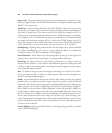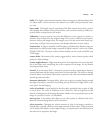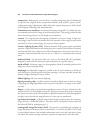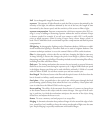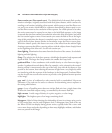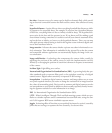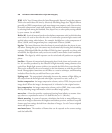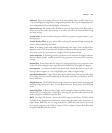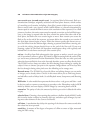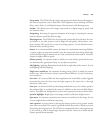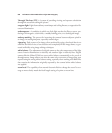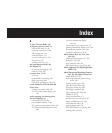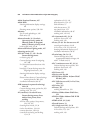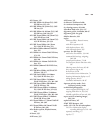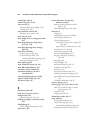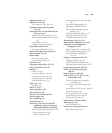rear-curtain sync (second-curtain sync) An optional kind of electronic flash syn-
chronization technique, originally associated with focal plane shutters, which consists
of a traveling set of curtains, including a front (first) curtain (which opens to reveal the
film or sensor) and a rear (second) curtain (which follows at a distance determined by
shutter speed to conceal the film or sensor at the conclusion of the exposure). For a flash
picture to be taken, the entire sensor must be exposed at one time to the brief flash expo-
sure, so the image is exposed after the front curtain has reached the other side of the
focal plane, but before the rear curtain begins to move. Rear-curtain sync causes the
flash to fire at the end of the exposure, an instant before the second or rear curtain of
the focal plane shutter begins to move. With slow shutter speeds, this feature can cre-
ate a blur effect from the ambient light, showing as patterns that follow a moving sub-
ject with the subject shown sharply frozen at the end of the blur trail. If you were
shooting a photo of The Flash, the superhero would appear sharp, with a ghostly trail
behind him. See also front-curtain sync (first-curtain sync).
red-eye An effect from flash photography that appears to make a person’s eyes glow
red, or an animal’s yellow or green. It’s caused by light bouncing from the retina of the
eye and is most pronounced in dim illumination (when the irises are wide open) and
when the electronic flash is close to the lens and, therefore, prone to reflect directly back.
The D7000’s red-eye lamp can reduce the effect during picture taking by causing the
subjects’ irises to contract just prior to the exposure. Image editors can fix red-eye after
the fact through cloning other pixels over the offending red or orange ones.
Retouch menu The D7000’s list of special effects and editing changes you can make
to images you’ve already taken. Choices in this menu allow you to trim/crop photos,
and add effects such as fisheye looks. See also Playback menu, Setup menu, and Shooting
menu.
RGB color A color model that represents the three colors—red, green, and blue—used
by devices such as scanners or monitors to reproduce color. Photoshop works in RGB
mode by default, and even displays CMYK images by converting them to RGB.
saturation The purity of color; the amount by which a pure color is diluted with white
or gray.
selective focus Choosing a lens opening that produces a shallow depth-of-field. Usually
this is used to isolate a subject in portraits, close-ups, and other types of images, by caus-
ing most other elements in the scene to be blurred.
self-timer A mechanism that delays the opening of the shutter for some seconds after
the release has been operated.
sensitivity A measure of the degree of response of a film or sensor to light, measured
using the ISO setting.
David Busch’s Nikon D7000 Guide to Digital SLR Photography498



